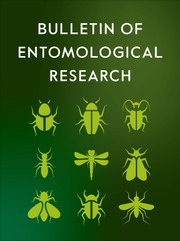No CrossRef data available.
Article contents
Demographic features of arrhenotokous parthenogenesis and bisexual reproduction of Panonychus ulmi using two-sex and 3D life table analysis
Published online by Cambridge University Press: 27 October 2025
Abstract
The European red spider mite, Panonychus ulmi Koch (Acari: Tetranychidae), is a major mite pest affecting a wide range of crops globally. Its rapid development and extensive dispersal enable P. ulmi to form large colonies through arrhenotokous reproduction, which subsequently produces bisexual offspring following oedipal phase mating. In this study, life tables for arrhenotokous and bisexual P. ulmi populations were constructed and assessed using the age-stage two-sex life table theory. To assess whether maternal age affects the offspring sex ratio, 3D life table analysis was conducted for both groups. Population projection for P. ulmi bisexual and arrhenotokous was based on life table data to evaluate the effect of arrhenotokous reproduction on population growth. Bisexual population parameters were r = 0.1828 d−1, λ = 1.2006 d−1, R0 = 44.80 offspring, and T = 20.79 d. The theoretical calculation of these parameters cannot be performed solely based on the survival rate and female fecundity of the P. ulmi arrhenotokous population, as only male offspring were produced during the first seven days before the arrival of the bisexual population. Although arrhenotokous parthenogenesis yields fewer offspring than bisexual reproduction, it significantly influences population dynamics by enabling a single virgin female to establish a bisexual population. Controlling offspring sex ratios enables rapid population growth and colonisation of new habitats. A comprehensive understanding of arrhenotokous reproduction is crucial for developing effective management strategies for P. ulmi. Future research should integrate genomic, ecological, and evolutionary perspectives to bridge the gap between laboratory and field conditions.
Information
- Type
- Research Paper
- Information
- Copyright
- © The Author(s), 2025. Published by Cambridge University Press.


